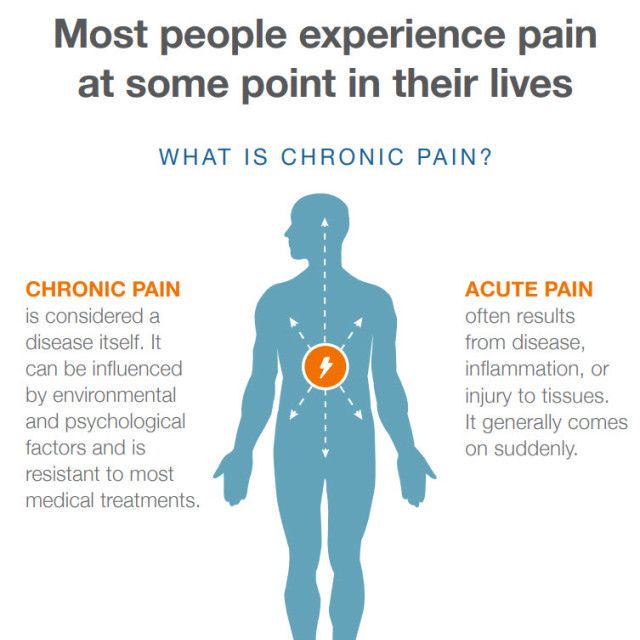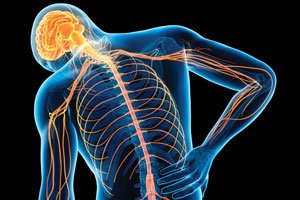

Chronic Pain affects 1 in 4 Canadians aged 15 years and older, and can have significant impacts on your; physical and mental health, your family and community life, society, and even the economy.

Pain is a normal, but unpleasant, experience you feel in response to what your brain believes to be a threatening situation and can involve actual or potential tissue damage (Butler & Moseley, 2003) Think of your pain as an alarm system; it has the capability of sending danger messages to your brain when your brain perceives that it is under threat – it is essential to help us avoid injury.
Pain is complex! The severity of the pain does not always match the degree of tissue damage. Paper cuts typically involve a minor amount of tissue damage (which heals with little or no care on your part), but the pain you feel is usually quite high, while some life threatening cancers can go undetected for years as there are no associated symptoms.
Tissue damage with injury leads to inflammation. Inflammation helps promote healing of your tissues. Different tissues take different amounts of time to heal, but typically, all tissues heal. Most commonly, as the tissue heals, the pain decreases.
Sometimes, the pain does not decrease as expected, and people experience persistent or chronic pain. With persistent pain our nervous system becomes sensitized. It acts like an oversensitive home alarm, neighbourhood chats walking by make provoke pain. Normally, it should take a lot more to set off the alarm, but it is too sensitive and providing too much, and often unnecessary, information.
There are a number of treatments and tools you can use to help address your persistent pain.
Knowledge is power. In order to learn how to better manage pain, it is important for those living with persistent pain to better understand it.
Two excellent resources for patients are:
Explain Pain (Butler and Moseley): a patient’s guide to pain
and
https://www.youtube.com/watch?v=RWMKucuejIs
Pacing & graded exposure. Sometimes after an injury pain can provoke negative beliefs or fear of movement or activity which results in us developing poor coping strategies and imbalances. You may avoid activities you love, activities that may ultimately be helpful to your pain. Having guidance as you gradually add back or increase normal, loved activities can decrease pain and fear or negative beliefs.
It is also important to address any underlying physical impairments, or imbalances. Physiotherapists are movement and exercise experts; we can help you address physical impairments. However, to manage persistent pain we need to consider the whole person. This aspect of treatment may involve medical interventions from your family doctor, psychological treatment, physical fitness training, breathing exercises and input from other health professionals.
Because persistent pain is a complex, individual experience your treatment also needs to be comprehensive and individual.
How can my Physiotherapist Help?
Patient Education: Education and increasing the patient’s understanding of chronic pain is an important step in the management of the condition.Exercise Therapy: Often, due to the severity of chronic pain, participation in exercise declines due to fear of worsening symptoms. Patients are often advised not to move through pain due to fear of increased pain. Physiotherapists will be able to advise and prescribe exercises that are pain-free or pain-reducing in order to get patients mobile again. The physiotherapist will create a programme of graded approach to exercise based on the individual’s needs, as well as aiming to improve strength and flexibility. Manual Therapy: With reduced movements or limited exercise due to the chronic pain, joints can become stiff and irritable. Your physiotherapist can help by manipulating or mobilising joints, which will restore movement. Soft Tissue Treatments: Your physiotherapist may decide to perform trigger point therapy, myofascial release, or stretching to improve movement and reduce pain. Soft tissue treatments can desensitise the area of pain. Acupuncture: This ancient Chinese medicine can be a useful alternative treatment option for chronic pain. The National Institute Of Health found studies which suggest that acupuncture is effective in chronic pain associated with the neck and back, headaches and osteoarthritis of the knee. Electrotherapy: Treatment options can be effective in decreasing the sensation of pain. Heat & Cold Therapy Treatment: This can be effective in the desensitising of pain. Heat helps the muscles to relax, encourages circulation and increases blood flow to the area, which can reduce pain. Cold therapy reduces the blood flow to the area, numbing the area and slowing down the pain messages sent from your nerves to your brain.
